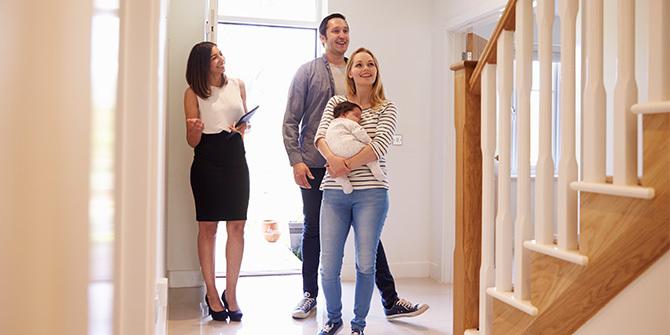Navigating the vast ocean of homebuying can seem daunting, especially for first-time buyers staring at the seemingly steep cliffs of down payments. However, a lifeline is thrown in the form of 3% down mortgages, a beacon of hope for those who dream of owning a home without a hefty initial investment. This guide is your compass to understanding the nuances of 3% down mortgages, illuminating the path through the sometimes foggy financial landscapes and helping you set course towards your dream of homeownership with confidence and clarity. So, pull up a chair and prepare to chart your journey into the welcoming waters of low down payment mortgages.
Table of Contents
- Unpacking the Basics of 3% Down Mortgages
- Navigating Eligibility Criteria for Minimal Down Payments
- Exploring the Long-Term Impacts of Low Down Payment Loans
- Tips for Successful Homeownership with a 3% Down Mortgage
- In Retrospect

Unpacking the Basics of 3% Down Mortgages
Stepping into the world of homeownership can seem like navigating a labyrinth, especially with financial terminologies and options. One of the increasingly popular paths for many first-time homebuyers is the 3% down mortgage. This option has opened the door for many who couldn’t save the traditional 20% down payment yet wish to own a home.
At its core, a 3% down mortgage allows you to purchase a home by paying just 3% of the home’s purchase price upfront. This is significantly less than the standard down payment, making it an attractive option for those with limited savings. For instance, for a house priced at $300,000, a 3% down payment translates to just $9,000, as opposed to the $60,000 required for a 20% down payment.
The eligibility for such loans is predominantly tailored towards first-time homebuyers, although repeat buyers can also qualify under certain conditions. Typically, these loans are backed by government-sponsored enterprises such as Freddie Mac and Fannie Mae, offering lenders a degree of security which in turn benefits the borrowers with potentially lower interest rates.
However, lower down payments come with their own sets of conditions and responsibilities. Here’s a quick look at what to expect:
- Credit Score Requirements: A credit score of at least 620 is often necessary, although terms can vary by lender.
- Private Mortgage Insurance (PMI): Expect to pay PMI until 20% of the principal balance has been paid off. This insurance protects the lender in case of default.
- Debt-to-Income Ratio: Lenders will consider your debt-to-income ratio (your total monthly debts divided by your gross monthly income). A ratio below 43% is typically required.
In addition, prospective homeowners should be aware of the potential interest rates with these types of mortgages. While interest rates for 3% down mortgages are generally competitive, they could be slightly higher than those of conventional loans with higher down payments. This increase is due to the greater risk that lenders assume with a lower upfront payment.
Furthermore, let’s break down potential monthly costs. Assuming a home price of $300,000, with a 3% down payment, and a fixed interest rate of 3.8%, you could be faced with the following financial scenario:
| Item | Cost |
|---|---|
| Monthly Principal & Interest | $1,323 |
| Estimated PMI | $250 |
| Estimated Property Taxes | $375 |
| Homeowners Insurance | $85 |
| Total per Month | $2,033 |
This table is a simple illustration and actual charges can vary based on local tax rates, insurance costs, and the specific conditions of the mortgage.
homebuyers interested in 3% down mortgages should consult with financial advisors and mortgage brokers to thoroughly understand the benefits and implications. A well-informed decision will ensure that the joy of owning a home is not overshadowed by financial strain.
while a 3% down mortgage can offer a valuable stepping stone into homeownership, it is vital to approach it with comprehensive planning and a clear understanding of the financial commitments involved. The ultimate goal is to achieve a sustainable and satisfying home ownership experience.

Navigating Eligibility Criteria for Minimal Down Payments
When you’re ready to step into home ownership but the daunting 20% down payment stands in your way, exploring mortgages that require minimal down payments might be your best bet. Specifically, 3% down mortgages provide a more attainable threshold for many prospective homebuyers. Here we’ll decode the nuances of qualifying for these loan types, ensuring you’re equipped to navigate the process with confidence.
Understanding Your Loan Options
- The Conventional 97 loan is primarily backed by Fannie Mae or Freddie Mac and necessitates that only one of the borrowers be a first-time homebuyer.
- FHA loans, known for their leniency, require a down payment as low as 3.5%, catering especially to those with lower credit scores.
- For those associated with the military community, VA loans tantalize with zero down payment requirements, though they are not accessible to the general public.
Credit Scores: A Vital Component
Credit requirements can vary significantly between different 3% down mortgage programs. Generally speaking, a higher credit score might open the door to more favorable interest rates and easier qualification criteria. For a Conventional 97 loan, lenders typically look for a credit score of 620 or higher.
First-Time Homebuyer Education
If you’re venturing into home ownership for the first time and opting for a 3% down payment, you might need to complete a homebuyer education course. This requirement is designed to prepare you for the financial responsibilities of owning a home and to ensure you fully understand the mortgage process.
| Loan Type | Minimum Credit Score | Down Payment Required | Homebuyer Education |
|---|---|---|---|
| Conventional 97 | 620+ | 3% | Yes (for first-time buyers) |
| FHA Loan | 580+ | 3.5% | No |
Debt-to-Income Ratios
Lenders will closely examine your debt-to-income ratio (DTI), a key indicator of your financial health. Most programs like the Conventional 97 loan favor a DTI below 45%. This ratio reflects your ability to manage monthly payments and repay debts.
Property Requirements
The property itself must meet certain criteria under 3% down payment programs. It should be your primary residence and in some cases, might need to conform to specific conditions or value assessments.
Down Payment Sources
Eligibility for these programs often extends to the sources of your down payment. It’s not uncommon for loans with minimal down payments to allow funds from gifts, grants, or community assistance programs. However, documenting the source of these funds will be a requisite part of the loan acquisition process.
By aligning your financial profile with the eligibility criteria detailed above, you pave the way to acquiring a home via a 3% down mortgage. Careful preparation and understanding of these elements will not only ease the buying process but set the stage for sustainable home ownership.

Exploring the Long-Term Impacts of Low Down Payment Loans
When diving into the world of low down payment loans, specifically those requiring as little as 3% down, it’s crucial to consider not just the immediate benefits but also the long-term impacts these types of mortgages may have on your financial health and homeownership trajectory.
Understanding equity growth is a key component. With a smaller down payment, you’re initially purchasing less of your home, which means it will take longer to build significant equity. This can have a ripple effect, especially if you’re aiming to utilize home equity loans or lines of credit in the future for renovations or emergencies.
Another critical aspect is the total cost paid towards the interest over the life of the loan. Typically, loans with lower down payments have higher interest rates or require private mortgage insurance (PMI), which can significantly increase the monthly costs. Over decades, this may amount to a substantial financial sum. Here’s how a 3% down payment affects costs compared to a traditional 20% down, assuming a $300,000 home purchase:
| Down Payment | Loan Amount | Interest Rate | Total Interest Cost (30 years) |
|---|---|---|---|
| 3% | $291,000 | 4.25% | $203,430 |
| 20% | $240,000 | 3.75% | $159,250 |
The likelihood of staying underwater should the market experience a downturn is higher if your down payment is minimal. This scenario can limit your mobility, particularly if you need to sell your home during an unsupportive market period, potentially leading to a loss.
Consider the implications of a lengthier mortgage insurance requirement. PMI is typically mandatory until you’ve built up at least 20% equity in your home, a timeline that is extended when starting with a 3% down payment. Here’s a breakdown of scenarios where PMI could extend over different periods:
- If home value increases rapidly: PMI may be required for less than five years.
- If home value grows steadily: PMI could be necessary for up to 10 years.
- If market conditions are poor: PMI might continue even longer, which would increase your costs.
With a scaled-down initial investment, homeowners might find themselves less incentivized to invest in property enhancements and significant upkeep given the marginal stake in home equity. This can adversely affect the property’s appreciation potential and overall condition by the time they decide to sell.
Lastly, the market dynamics themselves play a critical role. In strong market conditions, the rise in property values could potentially offset some of these drawbacks, allowing you to build equity more quickly than anticipated despite a low down payment. Conversely, a sluggish market could exacerbate challenges related to low equity and financial flexibility.
Thus, when considering a 3% down mortgage, it’s wise to approach this decision with a comprehensive understanding of both the potential benefits and the constraints it may impose on your long-term financial well-being and property investment.

Tips for Successful Homeownership with a 3% Down Mortgage
Embracing the dream of homeownership can be exciting, yet daunting, particularly when navigating the complexities of a 3% down mortgage. The lower upfront payment requirement makes these mortgage options highly appealing, especially for first-time homebuyers or those with limited savings. Here are several key strategies to ensure your journey with a low down payment mortgage is successful and stress-free.
1. Understand your loan: Before diving into the homebuying process, fully understand the specifics of the loan you’re considering. 3% down mortgages typically come with certain conditions and private mortgage insurance (PMI) requirements. Familiarize yourself with the interest rates, term lengths, PMI costs, and any potential penalties for early repayment.
2. Budget wisely: It’s crucial to calculate not just your monthly mortgage obligation, but also additional costs like property taxes, homeowners insurance, and maintenance expenses. Ensure your budget covers these items comfortably, so you’re not stretched too thin each month.
3. Maintain a healthy credit score: A higher credit score can often secure you a more favorable interest rate, which makes a significant difference over the lifetime of your loan. Keep your credit in good standing by paying bills on time, reducing debts, and avoiding new credit applications in the months leading up to your mortgage application.
4. Save for closing costs: While you may be focused on saving for the down payment, don’t forget about closing costs, which can range from 2% to 5% of the purchase price. These can include fees for appraisal, legal counsel, and various administrative procedures necessary to finalize the sale.
5. Emergency fund is key: Homeownership comes with unexpected responsibilities. Whether it’s a broken boiler or a leaking roof, having an emergency fund will help you handle these surprises without financial strain.
6. Consider future home expenses: Plan for potential future expenses like renovation or major repairs. Investigate the age of crucial components (like the roof or HVAC system) and anticipate any significant replacements or updates that might be needed soon.
| Component | Lifespan | Replacement Cost Estimate |
|---|---|---|
| Roof | 20-25 years | $5,000-$10,000 |
| HVAC System | 15-20 years | $4,000-$8,000 |
| Water Heater | 10-15 years | $800-$1,600 |
7. Stay informed: Real estate markets can fluctuate, impacting your home’s value and your mortgage conditions. Stay informed about market trends and economic factors that could affect your investment. Consider the long-term economic forecasts and how they might influence your financial stability and property value.
Securing a home with a 3% down mortgage definitely makes property ownership more accessible, but it requires careful planning and management. By following these strategies and maintaining a proactive and informed approach to homeownership, you can enjoy the rewards of your investment with peace of mind and financial security.
In Retrospect
As we close the chapter on our exploration of 3% down mortgages, remember this innovative approach could be your golden ticket into the world of homeownership. Such opportunities to enter the housing market with a reduced upfront cost open doors to possibilities, enabling dreams that once seemed out of reach. Yet, as with any significant journey, the path is lined with both promises and precautions. We’ve ventured through the mechanics, merits, and considerations of these mortgage options, equipping you with the knowledge to discern whether this is your passageway to a new home. As you stand on the threshold of decision-making, reflect on your financial landscape and consult with professionals who can offer personalized guidance tailored to your aspirations and circumstances. After all, every home purchase is not just a financial transaction but a foundational step towards your future. So tread thoughtfully, empower yourself with ample information, and let your journey of homeownership be as informed as it is inspired.
